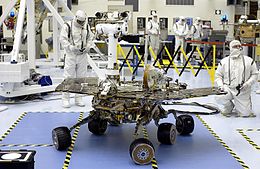MER-B
 |
|
| Mission type | Mars rover |
|---|---|
| Operator | NASA |
| COSPAR ID | 2003-032A |
| Website | JPL's Mars Exploration Rover |
| Mission duration | Planned: 90 sols (92.5 days) Current: 4711 sols (4841 days) since landing |
| Spacecraft properties | |
| Spacecraft type | Rover |
| Dry mass | 185 kilograms (408 lb) (rover only) |
| Start of mission | |
| Launch date | July 7, 2003 03:18 UTC |
| Rocket | Delta II 7925H-9.5 |
| Launch site | Cape Canaveral SLC-17B |
| Contractor | Boeing |
| Mars rover | |
| Landing date | January 25, 2004, 05:05 UTC SCET MSD 46236 14:35 AMT |
| Landing site | 1°56′46″S 354°28′24″E / 1.9462°S 354.4734°E |
| Distance covered | 43.79 km (27.21 mi)(as of 17 January 2017[update]) |
|
|
|

The launch patch for Opportunity, featuring Duck Dodgers (Daffy Duck)
Opportunity, also known as MER-B (Mars Exploration Rover – B) or MER-1, is a robotic rover active on Mars since 2004. Launched on July 7, 2003 as part of NASA's Mars Exploration Rover program, it landed in Meridiani Planum on January 25, 2004, three weeks after its twin Spirit (MER-A) touched down on the other side of the planet. With a planned 90 sol duration of activity (slightly more than 90 earth days), Spirit functioned until getting stuck in 2009 and ceased communications in 2010, while Opportunity remains active as of April 27, 2017, having already exceeded its operating plan by 13 years, 1 day (in Earth time). Opportunity has continued to move, gather scientific observations, and report back to Earth for over 50 times its designed lifespan. As of January 17, 2017, the rover had traveled 43.79 kilometres (27.21 miles). This date was mission time of Sol 4615.
Mission highlights include the initial 90 sol mission, finding extramartian meteorites such as Heat Shield Rock (Meridiani Planum meteorite), and over two years studying Victoria crater. It survived dust-storms and reached Endeavour crater in 2011, which has been described as a "second landing site".
The Jet Propulsion Laboratory (JPL), a division of the California Institute of Technology in Pasadena, California, manages the Mars Exploration Rover project for NASA's Science Mission Directorate in Washington, D.C.
...
Wikipedia
